Improving the Lower Ninth Ward
This is a narrative on how the Lower Ninth could be improved. This is a story of a little boy named Lucas and his best friend Julian. They went to the Martin Luther King Jr. Charter school. Every evening they would go the baseball park in the area to play and hangout with friends. One day when Lucas was returning home from school (which is a longer walk compared to Julian). He was confronted by a group of people who stole his left over lunch money and beast him up. When Lucas’s mother found about this, she was furious and went to talk to the mayor. The mayor calmed her down by saying that there are a group Urban Design students from Iowa State University that are coming to help and make the Lower Ninth a safer place for children and anyone. The students from Iowa State University met with the youth and the community to understand what is needed and how they can make the place safer. They came up with ideas of having safe corridors which are soft policed by people and surveillance cameras, Vacant properties are converted into places like club houses where the youth can hangout, learn and socialize, Incorporating Play Nola sites for younger kids, painting roads of the corridor to make people aware that this place child friendly, Illuminating the streets so that even in the night it is safe for someone young to get home.
Drawing a City
What is a city? Some may think of it as a concrete jungle but when we asked children from Ames Middle School, we got some unique answers during discussion.
An obvious answer is that a city is simply a big town. But another thing to consider and ask ourselves is what makes city successful? What type city would you want to live in?
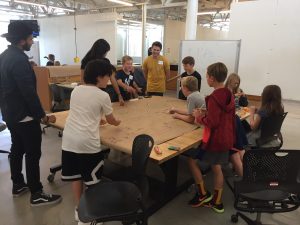
Before designing the “perfect” city, we asked the kids to think about what some of their favorite things about cities are.
Here’s what we got:
“What are your favorite things to do in Ames?”
“Going to my friend’s house after school and playing video games.”
“Going to the park”
What is your favorite city that you’ve been to and why?
“Singapore because it’s cool.”
“Denver because of 16th street”
What do you want to be when you grow up?
“A baseball player.”
“A rich engineer.”
What is important for a city to have?
“Running water.”
“A restaurant.”
“An airport so people can get here.”
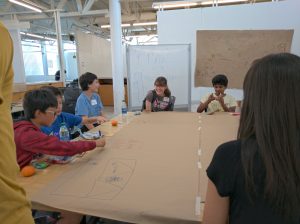
After discussion, we asked all the kids to work together to create a dream city of their own.
Draw a place that you would want to go to. What’s the weather like? Is it a big city or a small city?
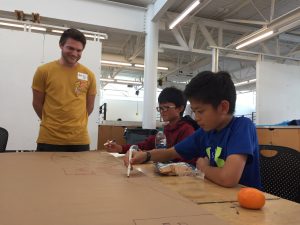

During the process, we asked them what they included what they did onto their drawings and what other elements would be important to include. We found that there was a pattern in both of the two groups that did this workshop exercise. They all started with buildings and structures, then included roads to connect them. Then with our help, they decided that it was also important to add other things such as schools, malls, parks, and bodies of water such as lakes and rivers. Lastly, some even went as far as to create landmarks, flags, and names for the city. Images attached below are the results of this exercise.
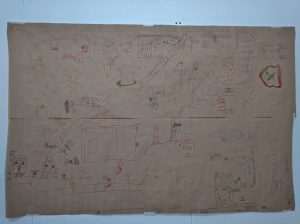
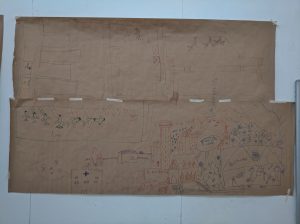
Thank you to the kids of Ames Middle School for their help in our design process.
-Sharissa, Sandeep, and Austin
Growing up Boulder
The role of Co-creation

The role of co-creation is what it simply means to create together. A way to develop cities and designs where the individuals who use the space or product are part of the design thinking process. It is inclusive design. An approach where the youth of the city actively takes part in the design making of a site or a project where they are able to relay their views so that their voices are heard and also it becomes a design which people of all ages can enjoy. Projects and concepts like this help children in team work, design understanding, creative thinking, practical thinking.
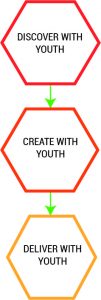
Growing up Boulder

“Growing Up Boulder’s vision is to make Boulder an exemplary child- and youth-friendly city. Growing Up Boulder’s mission is to empower Boulder’s young people with opportunities for inclusion, influence, and deliberation on local issues that affect their lives.”- growingupboulder.org
1. Ensure meaningful opportunities for young people’s participation in Boulder decision-making.
2. Make Boulder a more inclusive place for children and youth of all income levels, ethnicities and abilities.
3. Give GUB partners a voice in setting the direction of GUB projects.
4. Disseminate lessons learned from GUB to the community (Boulder-at-large, youth, academics, GUB partners, other child-friendly city communities).
PROJECTS:
Boulder’s redesigned civic area
In the year of 2012 Boulder’s civic area was part of a major re development by the City of Boulder. This area which is in the south of the city includes the main public library, public buildings of the municipality, museums, central park and green way. Fall of 2014 GUP worked alongside children and youth to come up with a re design for the Civic Area.
– 60 3rd graders at Whittier International Elementary School
– 18 10th graders in a Boulder High School Advancement via Individual Determinism (AVID) Class
– 21 Casey Middle School students in an applied science elective
– GUB staff, interns, graduate students, and visiting graduate students
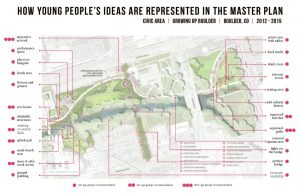
Valmont City Park
In the year of 2008 a concept plan was developed for the Valmont City Park. GUP took part in this process where they brought middle school and high school youth from YMCA’s University Hill, Crestview Elementary programs and the Youth Services Initiative (YSI) to come up with ideas for the project.
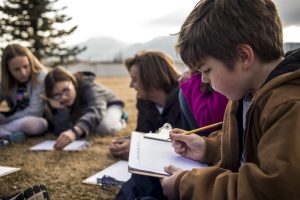
YMCA youth envisioning a new park; Photo Stephen Cardinale
“Data was gathered using different methods with each group. YMCA children were engaged with a Co-design activity during a field-trip to the site, where they created drawings of playgrounds in an imaginary newly developed park. YSI activities took place using photovoice during a field-trip to the site, and using a visual preference survey at the YSI meeting space at Salberg Park facilities. Parents of participating youth were interviewed at an informal social gathering for Dia de los Niños at the Manhattan housing site. Although responses varied between and within each group, two major themes that were present and highly prevalent for all three groups were nature and play, while two other themes, transport and food were mostly a concern of the older groups of youth and parents.”- Growing up boulder
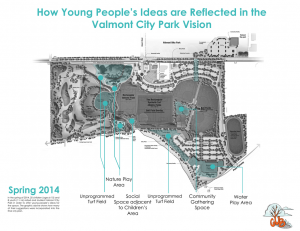
11th Street Corridor, Hill redevelopment project
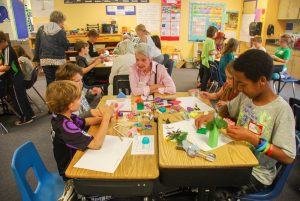
Photo by Erika Chavarria
In fall of 2017, fourth grade students from Flatirons elementary in the 11th street corridor, Hill redevelopment project where the students developed creative ideas to make the 11th street corridor a safe space and for all kinds of ages. Students went through a eight week process involving site analysis, precedent projects and presentation to the city. This project gave the city a better insight towards how to design or make a space which are child friendly, safe and can used by people of any age group.
Common themes that came up with the students were :
- Beautification of Space
- Interactive Activities and Art
- Safety for Children and Families
- Environmental Consciousness
- Pedestrian friendly Spaces
Tampa Bay, Florida
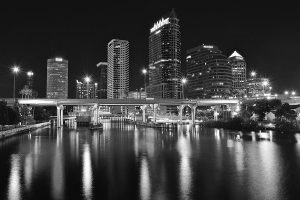
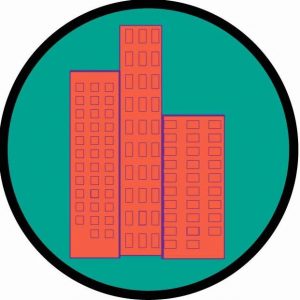
Why does climate change matter to Florida ?
” Florida is in the cross hairs of climate change, which is expected to bring not just more heat but also more flooding, stronger hurricanes, more toxic algae blooms and other woes to the Sunshine State. ” – Tampa Bay Times (2019)
Tampa Bay is located on the West Coast of Florida where there are risks of high sea level rises, natural disasters such as hurricanes or tornadoes. Tampa Bay is also that is very prone to storm surges.
Issues with Sea Level Rise
Currently in Florida the sea levels have rise 8 inches since 1950 and the speed of the rising water has only sped up. As of right now sea level is rising an inch every three years.
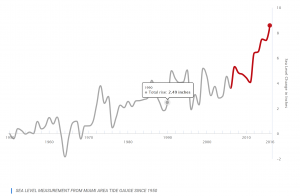 credits : sealevelrise.org
credits : sealevelrise.org
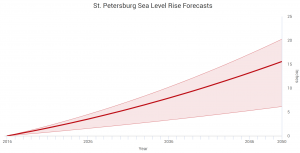
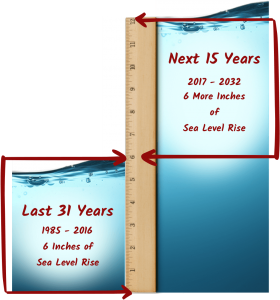
In Florida the bed rock is limestone which acts like a sponge which a porous material that allows water to seem through it. The bed rock adds on to the effects caused by sea level rise.

 Credits : sealevelrise.org
Credits : sealevelrise.org
Current Situation Possible Solution
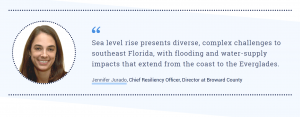
Tampa Bay has not been directly hit by a major hurricane since 1921 where it pushed in a flood of 11 feet and took eight lives. Back then the population of Tampa was about 50,000 and now it is in 3.4 million. What would happen if a category 5 hurricane hit the bay? The results would be catastrophic.
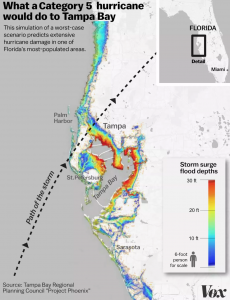 Credits : Vox
Credits : Vox
Storm surges are something that will often hit Tampa Bay here are some maps/data of counties which get affected by storm surges: Link
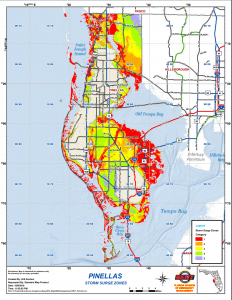
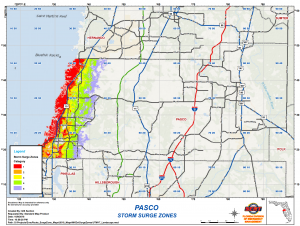
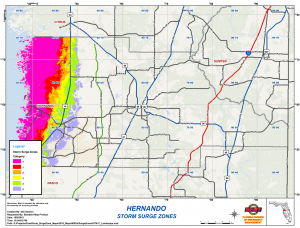
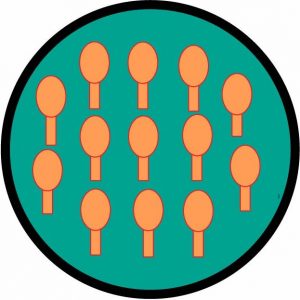
What is being done about it ?
The city of Tampa Bay which currently has a population of 3.1 million has begun steps in understanding climate change and its causes. What can be done? and understanding to move towards a resilient future. Four in every five people from Florida know about climate change and it’s affects.
The Tampa bay regional planning council (TBRPC) an association of local governments and gubernatorial representatives has setup a up a number of programs which include: Decision Support, Economic Development, Emergency management, Environmental planing and Resiliency.
Cost-conscious Storm preparation The cost-conscious Storm preparation is essentially a checklist prepared by TBRPC and The Federal Emergency Management Agency (FEMA) to inform or make the citizens of Florida of what to prepare before a hurricane or tornado hits. The document also provides information specific to people from different counties and how to get access to that information.
TBRPC Emergency Management Program
The emergency management program is a program that is part of the official regional awareness program, where they inform the local community on how to protect themselves, protect their businesses, community protection and community involvement.
The TBRPC have also come up with an All Hazards disaster planning guide which include hazards, including floods, tornadoes, hazardous materials, and terrorism which is freely available to anyone both in hard copies (specific locations) and soft copies on their website.
Tampa Bay Catastrophic Plan
“The Tampa Bay Catastrophic Plan was a document created to address the challenges of response and recovery during a catastrophic event in the Tampa Bay area.” – Tampa Bay Catastrophic Plan
Hazard Mitigation
Each county in Tampa develops a Local Mitigation Strategy (LMS) These plans are made or developed so as to reduce or eliminate risks involving natural or man-made hazards. These plans have to be made in agreement with the Disaster Mitigation Act of 2000 (DMA 2000) which is a system for collaboration between local and state authorities that understands and encourages the urgency for pre-disater planing, mitigation, and finding funds for projects through grant opportunities by the Federal government.
Agency on Bay Management
The Agency on Bay Management (ABM) is the committee for natural resources for the TBPRC which mainly handles the community organization for the protection of the Tampa Bay estuary. The ABM is a compilation of people or individuals from various departments usch as recreation, commercial fisheries, industrial, regulatory, academic and scientific sectors, local, regional, state and federal governments that serves an open discussion panel where issues and opportunities about and for the estuary are discussed.
Bay Surroundings
Bay surroundings is the environmental news group of Tampa Bay. It is a website where one can find information on nature events, festivals and awareness. It is also where one can find articles, journals, books and lots more information on climate change, on going environmental issues.
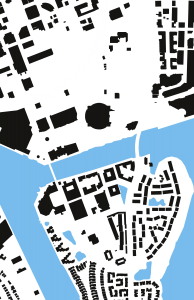
Figure ground study of Tampa Bay, Florida. Source: Mapbox
![]() How is the youth integrated into the idea of battling climate change?
How is the youth integrated into the idea of battling climate change?
About 21.7% of the population is under the age of 18. In a city like Tampa with high risks of natural disasters and climate change, it is important to include the youth as it for their future that everyone is working for and for that exact reason the youth should be educated in climate change.
Tampa Bay Sierra Club
The Tampa Bay Sierra Club consist of more than 2,700 supporters and members from the main counties all in the same goal of protecting the environment, identifying delicate spots in the environment and surroundings of Tampa.
“Our mission is to enjoy, explore and protect the natural places in Florida, to teach others to understand and respect the fragile environment in which we live, and to practice and promote the responsible use of Florida’s ecosystems and resources. Our group aims to provide access, education and community support for citizens’ concerns of the environment in the Tampa Bay area.” – Sierra Club Tampa Bay
Youth Climate Strike
“We, the youth of America, are striking because the science says we have just a few years to transform our energy system, reduce our greenhouse gas emissions, and prevent the worst effects of climate change. We are striking because our world leaders have yet to acknowledge, prioritize, or properly address our climate crisis. We are striking because marginalized communities across our nation —especially communities of color, disabled communities, and low- income communities— are already disproportionately impacted by climate change. We are striking because if the social order is disrupted by our refusal to attend school, then the system is forced to face the climate crisis and enact change. With our futures at stake, we call for radical legislative action to combat climate change and its countless detrimental effects on the American people. We are striking for the Green New Deal, for a fair and just transition to a 100% renewable economy, and for ending the creation of additional fossil fuel infrastructure. Additionally, we believe the climate crisis should be declared a national emergency because we are running out of time” – Youth Climate Strike